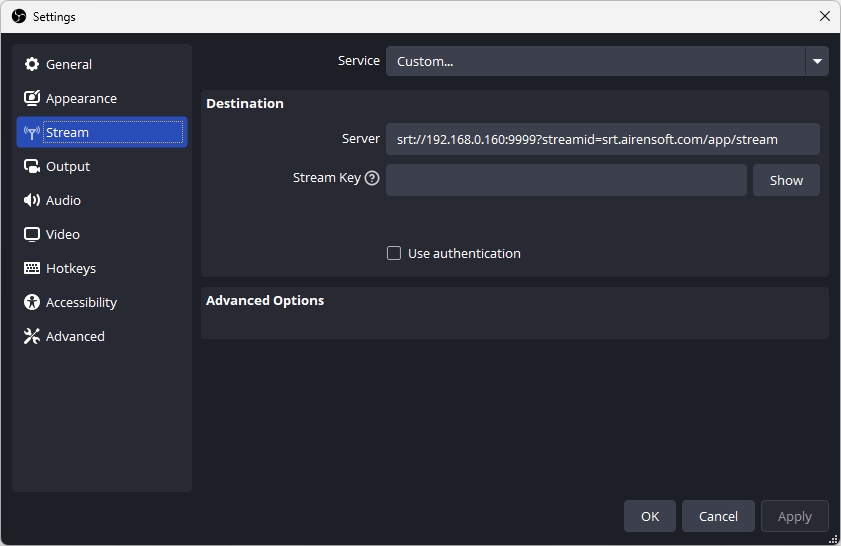SRT
Secure Reliable Transport (or SRT in short) is an open source video transport protocol and technology stack that optimizes streaming performance across unpredictable networks with secure streams and easy firewall traversal, bringing the best quality live video over the worst networks. We consider SRT to be one of the great alternatives to RTMP, and OvenMediaEngine can receive video streaming over SRT. For more information on SRT, please visit the SRT Alliance website.
Container
MPEG-2 TS
Transport
SRT
Codec
H.264, H.265, AAC
Additional Features
Simulcast
SRT uses the MPEG-TS format when transmitting live streams. This means that unlike RTMP, it can support many codecs. Currently, OvenMediaEngine supports H.264, H.265 and AAC codecs received by SRT.
Configuration
Bind
Set the SRT listen port as follows:
<!-- /Server/Bind -->
<Providers>
...
<SRT>
<Port>9998,9999</Port>
<WorkerCount>1</WorkerCount>
<ThreadPerSocket>true</ThreadPerSocket>
<StreamMap>
<Stream>
<Port>9999</Port>
<StreamPath>default/app/stream</StreamPath>
</Stream>
</StreamMap>
</SRT>
...
</Providers>Port
Specifies the listening ports for SRT connections. Multiple ports can be bound by separating them with commas.
WorkerCount (default : 1)
Defines the number of worker threads for handling SRT sockets. Increasing this value helps distribute traffic when there are many incoming sessions.
ThreadPerSocket (default : false)
Determines whether each socket is assigned a dedicated thread. If set to true, a new thread is created for every session when it connects and terminated when the session ends, while WorkerCount is ignored.
StreamMap
Provides a mapping function for encoders that do not support streamid. When a connection comes in without a streamid on a specific port, StreamMap maps that port directly to the specified StreamPath.
Using ThreadPerSocket can prevent a session thread from blocking while waiting for the Control Server to respond during AdmissionWebhooks, which would otherwise stop other sessions from proceeding. However, if too many sessions are connected, the overhead from thread context switching can become very high. On a 16-core system, practical cases have shown that around 100 sessions can run without issues.
Application
SRT input can be turned on/off for each application. As follows Setting enables the SRT input function of the application.
Encoders and streamid
streamidThere are various encoders that support SRT such as FFMPEG, OBS Studio, and srt-live-transmit. Please check the specifications of each encoder on how to transmit streams through SRT from the encoder. We describe an example using OBS Studio.
OvenMediaEngine classifies each stream using SRT's streamid. This means that unlike MPEG-TS/udp, OvenMediaEngine can receive multiple SRT streams through one port. For more information on streamid, see Haivision's official documentation.
Therefore, in order for the SRT encoder to transmit a stream to OvenMediaEngine, the following information must be included in the streamid.
streamid={Virtual Host Name}/{App Name}/{Stream Name}
OBS Studio
OBS Studio 25.0 or later supports SRT. Please refer to the OBS official documentation for more information. Enter the address of OvenMediaEngine in OBS Studio's Server as follows: When using SRT in OBS, leave the Stream Key blank.
srt://{OvenMediaEngine Host}:{SRT Port}?streamid={streamid}

Blackmagic Web Presenter
For configuring a Blackmagic Web Presenter, ATEM Mini Pro or similar device to stream to OvenMediaEngine over SRT, choose the "Custom URL H264/H265" platform option with the following syntax:
The default streaming profiles work well, and there are more advanced configuration options available if you edit the streaming.xml settings file
Multiple Audio Track
The SRT Provider supports multiple audio track inputs. This is automatically applied to the LLHLS Publisher.
If you want to label the input audio tracks, configure them as follows. This affects the player's audio selection UI when playing LLHLS.
SRT Socket Options
You can configure SRT's socket options of the OvenMediaEngine server using <Options>. This is particularly useful when setting the encryption for SRT, and you can specify a passphrase by configuring as follows:
For more information on SRT socket options, please refer to https://github.com/Haivision/srt/blob/v1.5.2/docs/API/API-socket-options.md#list-of-options.
Was this helpful?